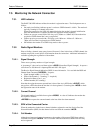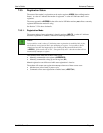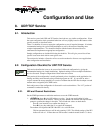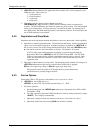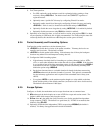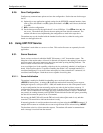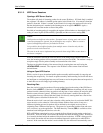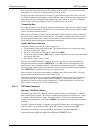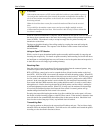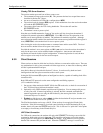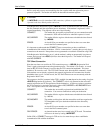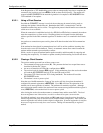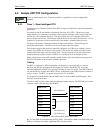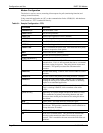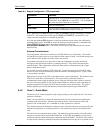
Configuration and Use DART 300 Modem
Page 68 2110212 Rev 1.0
flow control with the CDPD network to have packets held there until it is ready to receive them;
although there is a limit to how long the network will hold packets.
Escaping data state while keeping the modem in on-line condition (the session open), will cause
the modem to buffer incoming packets as with DTR flow control. If the modem is returned to data
state with the On-line command (O), the buffered data is then sent to the local host. Should the
local host close the session (hang-up or reset), any buffered data is discarded.
Transmitting Data
All outgoing packets are directed to the current client IP and port. The local host simply transmits
data to the modem PAD buffer. The PAD service will assemble and forward the packet according
to rules described in Section 6.6 above
.
If the receive lock feature is enabled, each transmission from the local host is treated as finishing
the service to the current client, releasing the lock. The modem will then make the next client in
the queue the new current client. If there are no clients in the queue, the last client is retained as
current and will be the destination for subsequent transmissions.
Closing UDP Server Sessions
The session remains open until one of these events occur:
• The command to hang-up the session (H). This presumes the host has escaped data state as
described in Section 6.6.3 above.
• An on-to-off transition of DTR with a configuration of &D2.
• The session inactivity timeout (S30) expires. If this mechanism closes the session the modem
will send the OK result.
• The modem is reset or power-cycled.
Note that use of the H command to “hang-up” the session will also de-register the modem if
configured for manual registration (+WS173=0). Use of H1 will force de-registration of the
modem even if auto-registration is enabled. The modem will remain de-registered. Although
auto-registration remains enabled, the modem will not resume auto-registration until the register is
reset (+WS173=1) or the modem itself is reset or power cycled.
After closing the session, the modem returns to command state and de-asserts DCD. The local
host can wait for another client call to open a new session.
Provided the modem is set to auto-register and H1 is not used to close the session, the modem is
ready for the next server session without further configuration. Auto-answer and network
registration will remain in their original configuration. If manual registration is used, the host
must re-register to be ready for the next session request.
8.3.1.3. TCP Server Sessions
Opening a TCP Server Session
The modem will check all incoming TCP session requests for the source IP address. If Friends
Only is enabled, the originator’s IP address is checked against entries in the Friends List. If there
is a match, or the Friends List is empty, the modem will also verify that the destination port is
matched to the listening port set in register +WS212. If no match is found the request is declined
(ignored).
Provided a connection request is acceptable, the modem will then behave as determined by the
setting of control signals (DTR and RTS), Quiet (Q), and the auto-answer setting (S0).
The modem allows the time set in register S7 to complete the connection handshake.
Note that Quiet mode (Q1) will suppress the RING and CONNECT codes.



